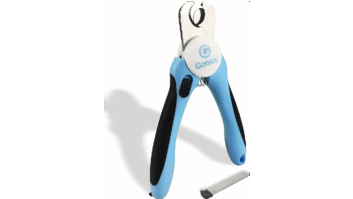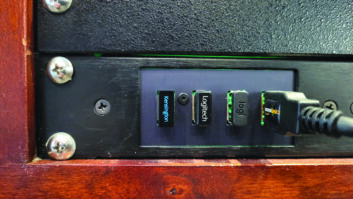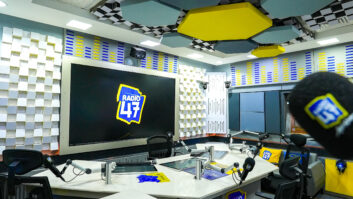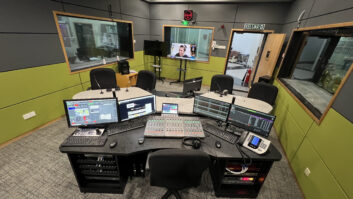(click thumbnail)Audio-Technica has entered the USB mic competition with its AT2020 USB mic, a build-out from its wildly successful AT2020 that answered the gauntlet tossed down by the many mic sellers who headed to China for cheap, if not always dependable, electronics manufacturing. AT followed.
The mics are QC’d three times by Audio-Technica before distribution in the United States: in China, in Ja-pan and at Audio-Technica in Stow, Ohio.
For a list price of $249 and a street price of about $150, the AT2020 USB mic will be an instant hit for anyone looking to reclaim desktop space normally occupied by a mixer. Not a computer desktop; the actual piece of furniture.
Why? Because you no longer need a preamp or mixer.
The AT2020 USB, like its non-USB sibling, has a medium-sized capsule with a fixed-charge back plate and a cardioid pattern. Frequency response is listed as 20 Hz to 16 kHz. It has a crisp presence peak that can be useful for recording tracks that need to cut through a mix.
It is solidly built, and comes with a simple but sturdy metal mic clip; table stand; and 9 foot USB cable. The mic requires 5 V DC USB power.
If 16 bit, 44.1 kHz audio is good enough for you, the real challenge may be the murky netherworld of USB and the various programs or applications to which the USB mic hopes to connect.
Product CapsuleAudio-Technica AT2020 USB Microphone
Plus

- Price
- Simplicity
- Crisp presence peak
- Tight cardioid pattern
- Comes with solid metal mic clip and table stand
- AT8137 foam pop filter controls plosives nicely
Minus
- Latency (delay) in the headphones while recording
- Only 16-bit; 24-bit would be nice
Price
$249 list
Contact
Audio-Technica | (330) 686-2600 | visit www.audio-technica.com.
To be sure, USB has latency issues that don’t become noticeable until you connect a mic to a computer and talk while listening with headphones. Recording voice tracks with this much delay can be off-putting to just plain impossible.
Latency also makes it impossible to tell in real time if your recording area is too slappy. To do that, you need to record something and listen back on good closed-back headphones. If you know your space, it doesn’t mat-ter. If you can deal with the delay or don’t need the headphones, no problem.
On the edge
When you plug the AT2020 USB into a USB port, a blue LED glows behind the head grille, letting you know that contact has been made.
Typically, you then need to take a trip to the computer’s audio preference panel to assign the mic to the proper input. The AT2020 USB manual goes into specific detail as to where to go and what to click on for Mac OS X, Windows XP and Vista PC computers. You also may have to check the specific application pref-erences or input panel.
The 2020 has a fairly tight cardioid pattern that disregards sounds from the side and rear. Although I didn’t have a non-USB AT2020 here for comparison for this review, I think they sound much alike.
There’s a bit of edge on the top. If you like a really natural sound, this may bother you, but if you like a little edge to cut through, it’s already there and you don’t need any EQ.
I was able to smooth the edge by using the half-inch-thick AT8137 foam pop filter. It controls plosives nicely, and the foam smoothes the high frequencies while still allowing a full low end when worked closely. It fits the AT2020 well and lets you get a lot closer than you might with a pop screen.
Most of my older Macs still running Mac OS X 10.4 had problems recording into Quicktime Pro until I up-graded to Quicktime 7.4.1. Quicktime recordings were two-channel. The first day I had problems recording with Garage Band 3.0.4 and Soundtrack Pro (STP) 2.0.1 on the 10.4 Macs. The next day and since then, the only problems I’ve had with those two applications is figuring out the eccentricities in their GUIs.
I also was able to record properly with the AT2020 USB using Audacity on a 500 MHz G4 Mac running OS X 10.4.11. The program itself is awkward, but hey, it’s free.
Both of my newer Intel Macs (a Pro and a MacBook) worked more smoothly with Quicktime, Garage Band and STP from the start. There were a few hitches, but nothing that couldn’t be adjusted.
Metering and pan controls on these programs are a little short compared to the Pro Tools system I use, and it took extra effort to record in mono rather than stereo.
When my wife asked about using Skype on her Mac G4 so she could talk longer with her best friend on the west coast, I was temporarily stumped for what mic I could plug in to the Mac. As it turns out, the AT2020 USB worked really well with Skype and iChat, even at a distance of 18 inches.
The table stand was perfect for positioning the mic. Stick one on your desk for that “David Letterman” look. Skype’s audio is simplex rather than duplex (at least on my Macs), but the sound quality of its compression algorithm is better than any POTS line I’ve heard.
The day has finally come when you can, almost without problems, discard your desktop mixer and/or mic preamp. As a final test, I sat in front of a new iMac, Apple’s latest all-in-one computer. In a quiet room, the iMac was quiet enough to allow bare voice tracks to be recorded with the AT2020 USB plugged into a USB port on the backside of the large screen. In the average radio news room, you’ll never hear the iMac. We’ve come a long way.







